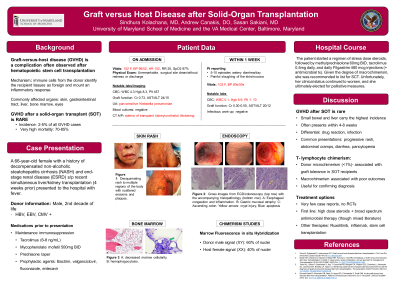Sunday Poster Session
Category: Liver
P1084 - Graft-Versus-Host Disease After Simultaneous Liver/Kidney Transplantation
Sunday, October 22, 2023
3:30 PM - 7:00 PM PT
Location: Exhibit Hall

Has Audio
- SK
Sindhura Kolachana, MD
University of Maryland Medical Center
Baltimore, MD
Presenting Author(s)
Sindhura Kolachana, MD, Andrew Canakis, DO, Sasan Sakiani, MD
University of Maryland Medical Center, Baltimore, MD
Introduction: Acute graft-versus-host disease (GVHD) is a serious complication of hematopoietic stem cell transplantation, though can rarely present after solid organ transplantation (SOT). This condition occurs when passenger lymphocytes within the transplanted donor organ(s) become activated and attack host tissues. GVHD after SOT is associated with a mortality rate of 70-85%.
Case Description/Methods: A 66-year-old woman with a history of non-alcoholic steatohepatitis cirrhosis and end-stage renal disease underwent a simultaneous liver and kidney transplant and re-presented one month after transplantation with urosepsis and diarrhea. She was initially treated with antibiotics; however, within two days of admission, she developed an acute-onset diffuse rash and sloughing of the skin and mucosa. Physical exam was notable for painful erythematous erosions present to the face, chest, back, anogenital regions, and oral mucosa. Skin biopsies demonstrated subepidermal blistering without full-thickness necrosis concerning for acute GVHD or Stevens Johnson Syndrome. Regarding diarrhea, the patient was experiencing five to ten episodes of non-bloody diarrhea per day. Bidirectional endoscopy demonstrated grossly friable and hypervascular mucosa, and pathology showed diffuse apoptosis and crypt injury with features suggestive of GVHD or drug-related injury.
During this hospitalization, the patient also experienced pancytopenia (white blood cell 0.1 k/uL, hemoglobin 7.9 g/dL, platelets 1 k/uL). Bone marrow biopsy demonstrated hypoplasia and stromal damage. Marrow fluorescence in situ hybridization chimerism studies revealed 60% involvement of donor cells, concerning for macrochimerism. Given the presentation of multi-organ involvement (skin, gastrointestinal tract, and marrow) with histopathology suggestive of GVHD, and significant donor macrochimerism, the patient met criteria for acute GVHD and was started on IV immunosuppression. The patient’s clinical status continued to worsen and given the poor prognosis, she elected for palliative measures and expired the next day.
Discussion: This case illustrates a case of acute GVHD after simultaneous liver/kidney transplantation. GVHD after SOT is difficult to diagnose early given the rarity of the condition and clinical similarity to processes such as infection and drug-related injury. However, it is important to have a high index of suspicion as it may quickly progress to multi-organ dysfunction and death.
Disclosures:
Sindhura Kolachana, MD, Andrew Canakis, DO, Sasan Sakiani, MD. P1084 - Graft-Versus-Host Disease After Simultaneous Liver/Kidney Transplantation, ACG 2023 Annual Scientific Meeting Abstracts. Vancouver, BC, Canada: American College of Gastroenterology.
University of Maryland Medical Center, Baltimore, MD
Introduction: Acute graft-versus-host disease (GVHD) is a serious complication of hematopoietic stem cell transplantation, though can rarely present after solid organ transplantation (SOT). This condition occurs when passenger lymphocytes within the transplanted donor organ(s) become activated and attack host tissues. GVHD after SOT is associated with a mortality rate of 70-85%.
Case Description/Methods: A 66-year-old woman with a history of non-alcoholic steatohepatitis cirrhosis and end-stage renal disease underwent a simultaneous liver and kidney transplant and re-presented one month after transplantation with urosepsis and diarrhea. She was initially treated with antibiotics; however, within two days of admission, she developed an acute-onset diffuse rash and sloughing of the skin and mucosa. Physical exam was notable for painful erythematous erosions present to the face, chest, back, anogenital regions, and oral mucosa. Skin biopsies demonstrated subepidermal blistering without full-thickness necrosis concerning for acute GVHD or Stevens Johnson Syndrome. Regarding diarrhea, the patient was experiencing five to ten episodes of non-bloody diarrhea per day. Bidirectional endoscopy demonstrated grossly friable and hypervascular mucosa, and pathology showed diffuse apoptosis and crypt injury with features suggestive of GVHD or drug-related injury.
During this hospitalization, the patient also experienced pancytopenia (white blood cell 0.1 k/uL, hemoglobin 7.9 g/dL, platelets 1 k/uL). Bone marrow biopsy demonstrated hypoplasia and stromal damage. Marrow fluorescence in situ hybridization chimerism studies revealed 60% involvement of donor cells, concerning for macrochimerism. Given the presentation of multi-organ involvement (skin, gastrointestinal tract, and marrow) with histopathology suggestive of GVHD, and significant donor macrochimerism, the patient met criteria for acute GVHD and was started on IV immunosuppression. The patient’s clinical status continued to worsen and given the poor prognosis, she elected for palliative measures and expired the next day.
Discussion: This case illustrates a case of acute GVHD after simultaneous liver/kidney transplantation. GVHD after SOT is difficult to diagnose early given the rarity of the condition and clinical similarity to processes such as infection and drug-related injury. However, it is important to have a high index of suspicion as it may quickly progress to multi-organ dysfunction and death.
Disclosures:
Sindhura Kolachana indicated no relevant financial relationships.
Andrew Canakis indicated no relevant financial relationships.
Sasan Sakiani indicated no relevant financial relationships.
Sindhura Kolachana, MD, Andrew Canakis, DO, Sasan Sakiani, MD. P1084 - Graft-Versus-Host Disease After Simultaneous Liver/Kidney Transplantation, ACG 2023 Annual Scientific Meeting Abstracts. Vancouver, BC, Canada: American College of Gastroenterology.
